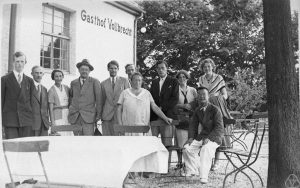
Emmy Noether was the great creator and promoter of abstract and conceptual methods in algebra, whose influence also extended to number theory, geometry and topology. This blog has already written about her in several posts (see this one, this one and even the next-to-last paragraph of this one). Although she published only three papers in collaboration with other mathematicians, she by no means lived an isolated professional life, but set up an international school of commutative algebra in Göttingen, where students and established mathematicians from all over the world came to study.
In addition, according to the usual practice of the time, she maintained epistolary exchanges or periodic conversations with some of the other major figures in the field (see, for example, the letters between her and Helmut Hasse, compiled and commented – with some differences between one edition and another – in [4] and [5]). One of them is the other protagonist of this post, Emil Artin, who is considered the other founder of modern algebra along with Noether.
Emmy Noether spoke with intensity and liveliness, both in terms of rhythm and mathematical content. According to Natasha Artin Brunswick, Emil Artin’s ex-wife, he had a special method of discussing mathematics with Noether (boldface points to italics in the original text):
They would go for walks, and he would ask her a question, and she would start talking very, very fast. He knew he couldn’t keep up with her, so he would let her talk for about half an hour and then say “Emmy, but I didn’t understand a word, could you please tell me again.” And she would start again. But in the meantime they would walk very fast, and she would get a little slower and go more slowly through it again. The second time he would say, “Emmy, I haven’t understood it yet”. On the third rendition he would understand what she was talking about. By this time, you see, she was so tired that her speed would slow down. She was so amazingly lively!

The anecdote is quoted by Clark Kimberling in his biography Emmy Noether and Her Influence, which forms part of [2]. In another article ([3]), he reports another story by Artin Brunswick about our two protagonists. Before presenting it, let us put it in context. In 1933, due to the racial purity laws of the Third Reich, Noether, like many of her compatriots, was forced into exile and left somewhat hastily, only to end up working at Bryn Mawr College in the United States. Once settled there, she returned to Germany in the summer of 1934 and, among other activities, visited Artin, who had a professorship in Hamburg.
On the other hand, the word Führer, by which Hitler was designated, means “guide”, “leader” or “conductor”. The latter word also designates a concept of number theory, introduced by Artin in 1930 ([1]). With both details in mind, we can understand the following situation discussed by Artin Brunswick (again, the bold text is in italics in the original text):
Now the one thing I remember most vividly is the trip on the Hamburg “Untergrund”, which is the subway in Hamburg. We picked up Emmy at the Institute [of Mathematics], and she and Artin immediately started talking mathematics. At that time it was “Idealtheorie” [ideal theory], and they started talking about “Ideal”, “Führer”, and “Gruppe” [group], and “Untergruppe” [subgroup], and the whole car suddenly started pricking up their ears. And I was frightened to death–I thought, my goodness, next thing’s going to happen, somebody’s going to arrest us. Of course, that was in ’34, and all. But Emmy was completely oblivious, and she talked very loud and very excited, and got louder and louder, and all the time the “Führer” came out, and the “Ideal”. She was very full of life, and she constantly talked very fast and very loud.
Acknowledgements. This post was prompted by the author’s participation in the main conference of the Noether Year, held by the Faculty and Institute of Mathematics of the University of Seville. I am grateful to the organisers, who are also “usual suspects” on this blog, for inviting me to talk. I have to thank, indirectly, Clark Kimberling for his articles and Natasha Artin Brunswick for her memory and for preserving, I suppose among other stuff, the three photographs featured in this post. The cover photo is also of Artin, Noether and Köthe, at the gates of the Institute of Mathematics in Göttingen. They can be found here and here.
References
[1] Emil Artin, Zur Theorie der L-Reihen mit allgemeinen Gruppencharakteren. Abh. Math. Semin. Univ. Hambg. 8, 292–306 (1931).
[2] James W. Brewer and Martha K. Smith (eds.), Emmy Noether: A Tribute to Her Life and Work. Marcel Dekker Inc. (1981).
[3] Clark Kimberling, Emmy Noether, Greatest Woman Mathematician. Mathematics Teacher 84, Number 3, 246–249 (1982).
[4] Franz Lemmermeyer and Peter Roquette (eds.), Helmut Hasse und Emmy Noether: Die Korrespondenz 1925–1935. Universitätsverlag Göttingen (2006).
[5] Franz Lemmermeyer and Peter Roquette (eds.), The Hasse – Noether Correspondence 1925–1935. Springer Cham (2023).

Leave a Reply